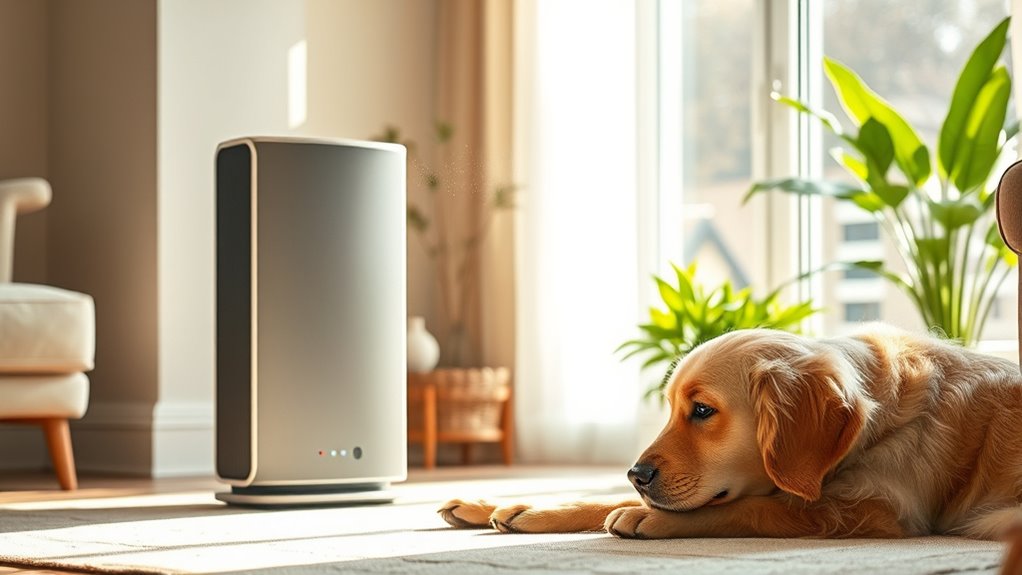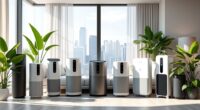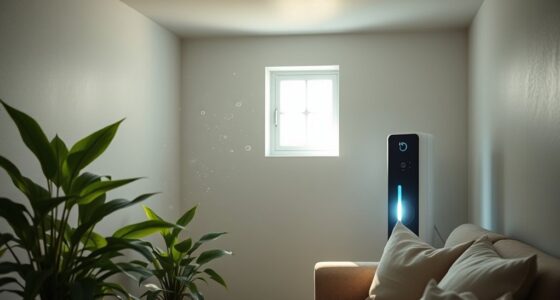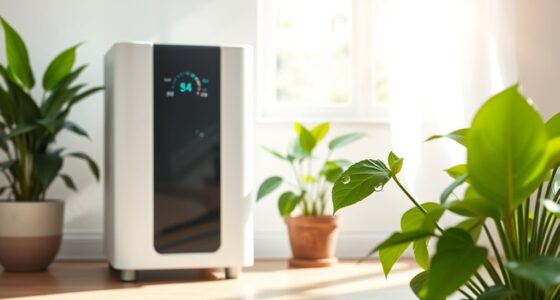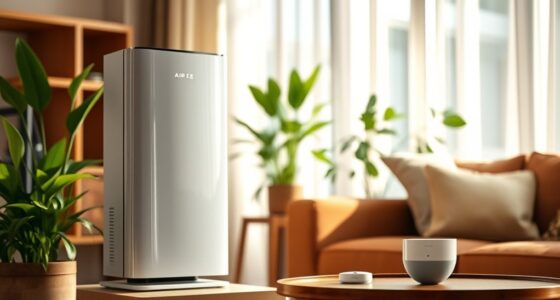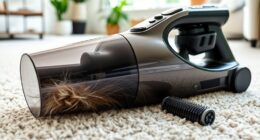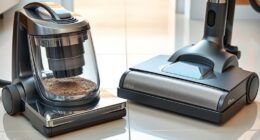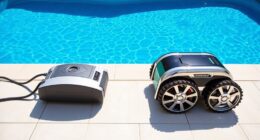Air purifiers are a must-have for pet owners dealing with dander. These devices use HEPA filters to capture tiny allergens, keeping your home cleaner and healthier. With regular filter replacements and strategic placement, you can greatly improve your indoor air quality. Vacuuming with HEPA filters and grooming your pets regularly also helps manage dander. By combining these strategies, you can create a more comfortable environment for you and your furry friends—let’s explore effective options available!
Key Takeaways
- Invest in an air purifier with a True HEPA filter to effectively capture pet dander and improve indoor air quality.
- Regularly groom pets to reduce dander and hair, enhancing the effectiveness of air purification systems.
- Establish designated low-allergen zones in your home to limit allergen exposure and create quieter spaces for allergy-sensitive individuals.
- Use HEPA vacuums and clean surfaces frequently to eliminate pet hair and dander from your living environment.
- Replace air purifier filters every 3-6 months to maintain optimal performance and ensure effective allergen removal.
Understanding Pet Dander: What It Is and Why It Matters
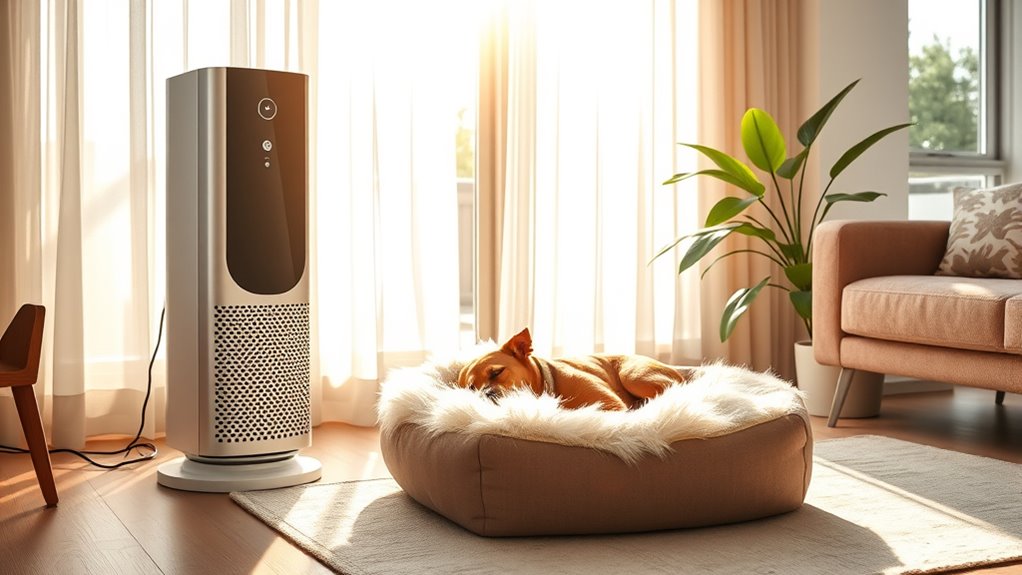
When you have pets at home, understanding pet dander is vital for managing allergies and maintaining a healthy living environment.
Pet dander consists of tiny skin flakes that can remain airborne for hours, acting as potent allergens. These airborne particles contain proteins from saliva, urine, and skin, which can trigger allergic reactions in about 30% of allergy sufferers. It’s significant to highlight that cat allergies are twice as common as dog allergies, underscoring the notable impact of pet-related allergens. In homes with pets, concentrations of pet dander can be 100-1000 times higher than in pet-free homes, affecting indoor air quality. To promote respiratory health and create a healthier indoor environment, effective air purification and cleaning strategies are vital. Many air purifiers utilize HEPA filters to capture up to 99.97% of airborne particles, significantly reducing allergens like pet dander. Additionally, using air purifiers with smart features can provide real-time air quality monitoring, enhancing overall effectiveness. Regular maintenance, such as cleaning filters, can help ensure that air purifiers operate at peak performance, further improving indoor air quality. Furthermore, studies indicate that air purifiers can also improve respiratory health, making them an essential addition for pet owners. Incorporating UV light technology in air purifiers can further enhance the elimination of harmful bacteria and viruses present in homes with pets.
How Air Purifiers Combat Pet Dander
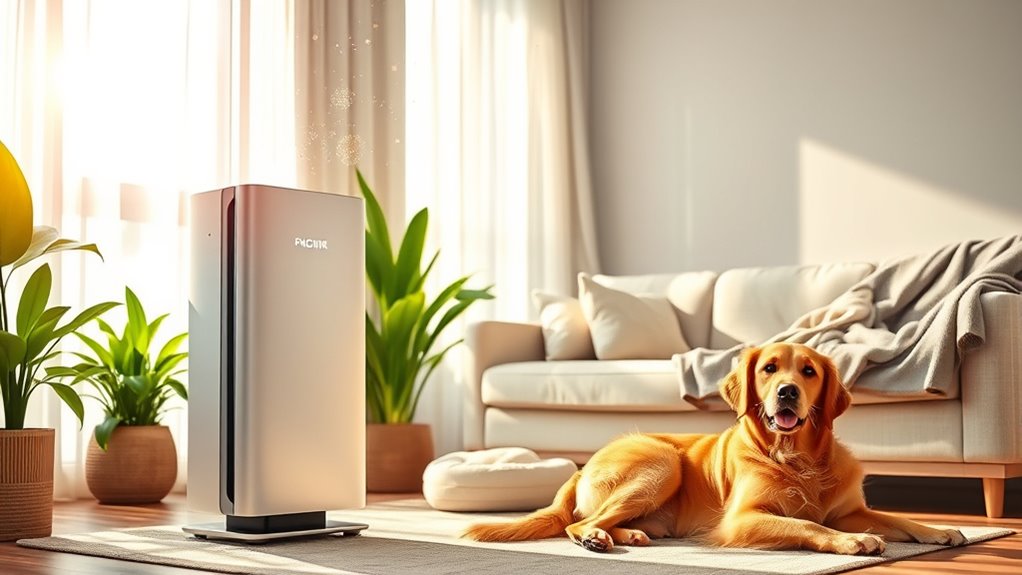
Air purifiers play an essential role in combating pet dander, ensuring your home remains a safe haven for allergy sufferers. Equipped with HEPA filters, these devices capture at least 99.97% of airborne particles, including tiny pet dander particles. Additionally, models like the LEVOIT Air Purifier for Home are specifically designed for allergy relief and pet hair removal. Furthermore, using energy-efficient systems like heat pumps can complement air purifiers by improving overall indoor air quality. In addition, selecting air purifiers with multi-surface capability can enhance their effectiveness in various areas of your home.
To effectively manage allergens in your indoor environment, choose an air purifier with a Clean Air Delivery Rate (CADR) of at least 200. Many advanced purifiers also feature activated carbon filters that neutralize odors, enhancing air quality. Incorporating natural elements like plants can further improve indoor air quality and create a healthier atmosphere.
Regular filter replacement every 3-6 months is vital for maintaining efficiency and preventing the recirculation of pet dander. By continuously operating your air purifier, you can greatly lower dander concentrations, creating a healthier home for both you and your furry friends. Additionally, the use of HEPA filters ensures that even the smallest particles are captured, providing maximum protection against allergens.
Key Features to Look for in Pet Dander Air Purifiers
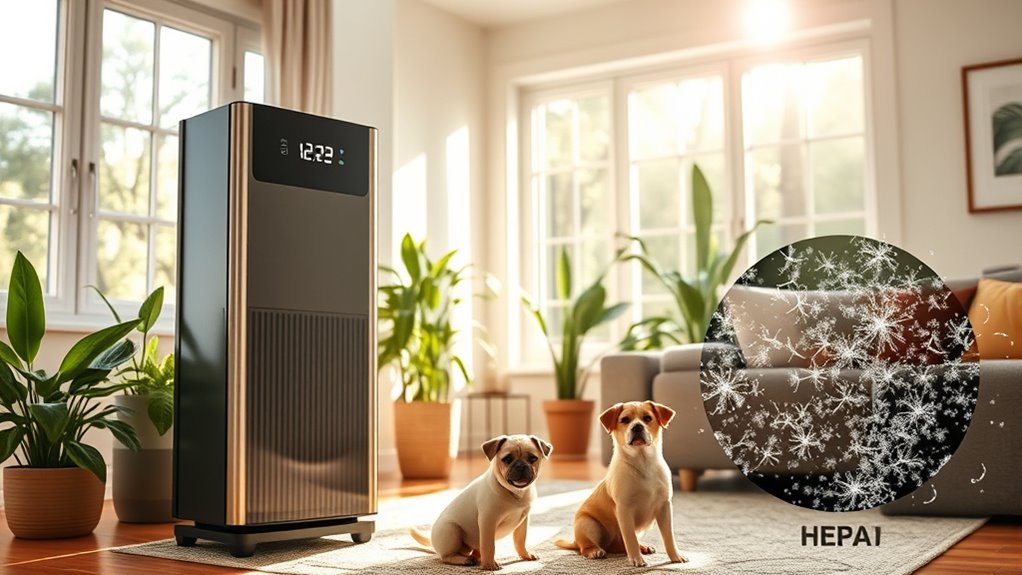
Choosing the right air purifier for managing pet dander involves understanding key features that enhance its performance. Here are some essential aspects to take into account:
- True HEPA Filters: Look for air purifiers specifically with true HEPA filters, which capture at least 99.97% of particles as small as 0.3 microns, effectively trapping pet dander. These filters are known for their high filtration efficiency, making them ideal for homes with pets. Additionally, many models are designed to integrate with smart home devices, allowing for seamless control over your air quality. Regular skin treatments can also help mitigate allergic reactions to pet dander by improving skin resilience. Consider models that offer energy monitoring features to help keep utility costs down while ensuring clean air.
- Multi-Layered Filtration Systems: These models include pre-filters to capture larger hair and dust, improving efficiency.
- Activated Carbon Filters: Essential for neutralizing odors associated with pet dander, creating a healthier environment for you.
- CADR Rating: Verify a CADR rating of at least 200 for pet dander to effectively remove airborne pollutants.
Also, take into account filter replacement indicators for easy maintenance. Additionally, regular filter cleaning and replacement is crucial for optimal performance and air quality in homes with pets.
These features will help pet owners breathe easier!
Placement and Maintenance Tips for Maximum Effectiveness
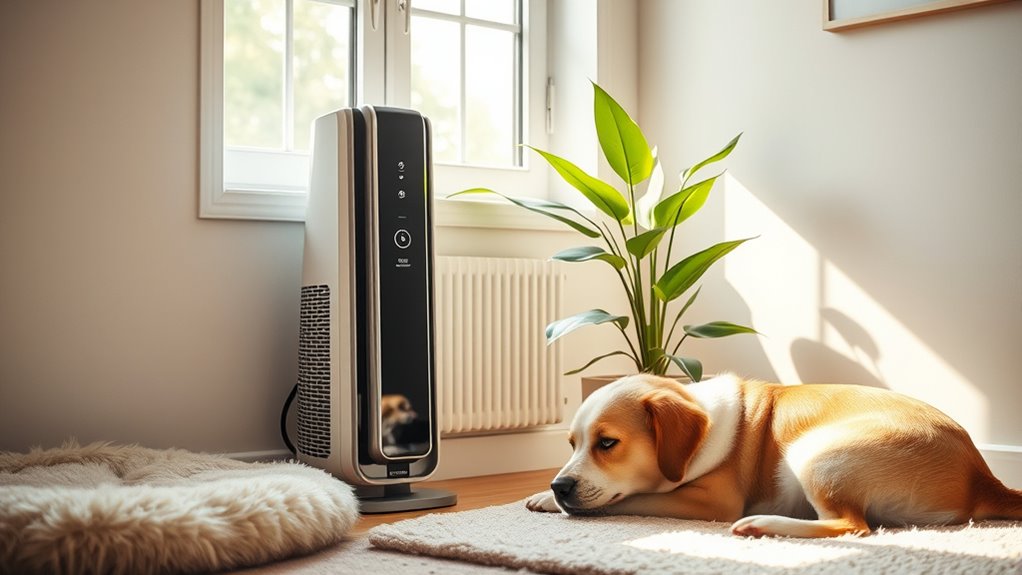
To maximize the effectiveness of your air purifier in combating pet dander, place it in the rooms where your pets spend the most time, such as their sleeping areas or play zones. Make sure its CADR is at least two-thirds of the room’s square footage to enhance performance. Regularly check for dust and debris accumulation, as this can hinder the air purifier’s effectiveness. Additionally, implementing regular grooming can significantly reduce the amount of dander in the air. Maintaining your air purifier is crucial, as regular maintenance ensures optimal air quality; regularly inspecting and cleaning washable pre-filters every 2-4 weeks is recommended. Replacing HEPA filters every 3-6 months, adjusting based on usage, is also essential to prevent airborne contaminants from affecting your home. Keeping your air purifier running continuously will enhance indoor air quality by increasing air changes per hour (ACH). Additionally, a clean home environment is essential for reducing allergens and pollutants, which can further improve the effectiveness of your air purifier.
| Maintenance Tip | Frequency |
|---|---|
| Clean pre-filters | Every 2-4 weeks |
| Replace HEPA filters | Every 3-6 months |
| Replace carbon filters | As needed |
| Continuous operation | Always |
| Ideal placement | Near pets’ areas |
Beyond Air Purification: Complementary Strategies for Pet Owners
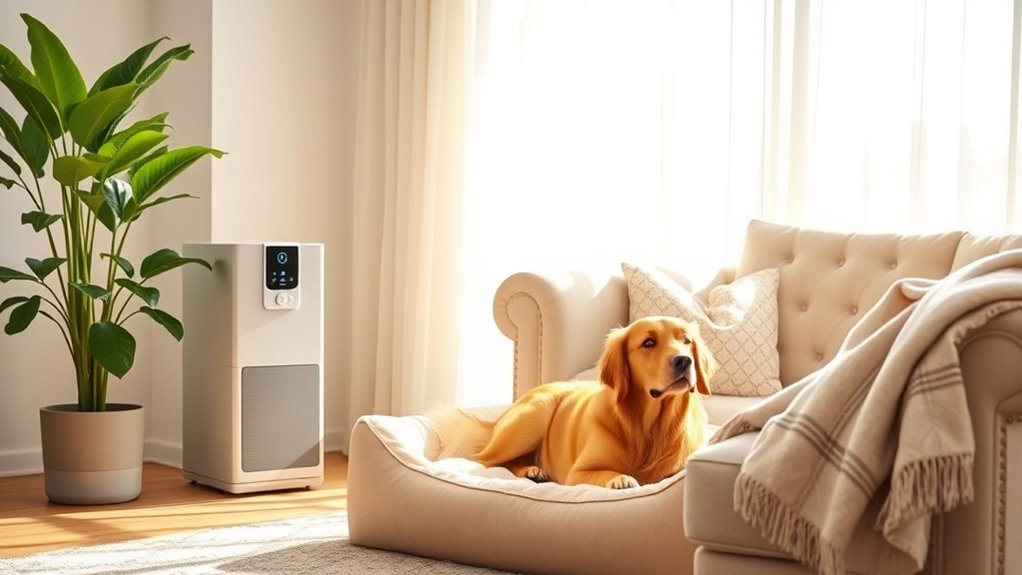
To keep your home’s air quality high, consider regular grooming for your pets, as brushing helps reduce dander.
Pair that with strategic cleaning practices, like using HEPA vacuums and maintaining hard surfaces, for even better results.
You might also create low-allergen zones to limit where your pets can roam, further improving the air you breathe. Additionally, using air purifiers for pets can significantly enhance your indoor air quality by filtering out allergens and pollutants.
Regular Pet Grooming
Regular grooming can make a noticeable difference in managing pet dander and improving your home’s air quality.
By implementing effective grooming practices, you can reduce allergens and create a healthier environment for you and your pets.
Here are some strategies to follow:
- Brush your dog 3-4 times a week and your cat weekly to minimize dander.
- Schedule professional grooming every 4-8 weeks, especially for shedding breeds.
- Bathe your pets with suitable shampoos to eliminate allergen proteins on their coats.
- Designate low-allergen zones in your home for grooming, helping contain allergens.
Combining these grooming practices with air purifiers that use HEPA filtration will greatly improve indoor air quality and alleviate allergy symptoms.
Strategic Cleaning Practices
While air purifiers play an essential role in improving indoor air quality, they work best when paired with strategic cleaning practices that target pet dander directly. Regular grooming, like brushing your dog 3-4 times a week and bathing them with appropriate shampoos, can greatly reduce the amount of allergens in your home. Additionally, using HEPA vacuums for cleaning surfaces and floors effectively captures pet hair and dander.
| Task | Frequency | Benefits |
|---|---|---|
| Grooming | 3-4 times/week (dogs) | Reduces dander |
| Using HEPA vacuums | Weekly | Captures allergens |
| Cleaning surfaces & floors | 2-3 times/week | Improves air quality |
Implementing these practices can create a healthier environment for pet owners dealing with allergens.
Designated Low-Allergen Zones
Creating designated low-allergen zones in your home can greatly reduce the presence of pet dander and improve your overall air quality.
These areas are essential for allergy-sensitive individuals, providing a refuge from allergens. To establish effective low-allergen zones, consider the following tips:
- Restrict pet access: Choose specific rooms or areas where pets aren’t allowed.
- Use HEPA filters: Regularly run air purifiers equipped with HEPA filters in these zones.
- Maintain cleanliness: Vacuum and dust frequently to minimize allergen accumulation.
- Groom your pets: Regular grooming can considerably reduce pet dander in your indoor environment.
Incorporating these strategies, along with air purifiers, can enhance your respiratory health and create a healthier home for pet owners.
Living Better With Pets: a Balanced Approach to Dander Management
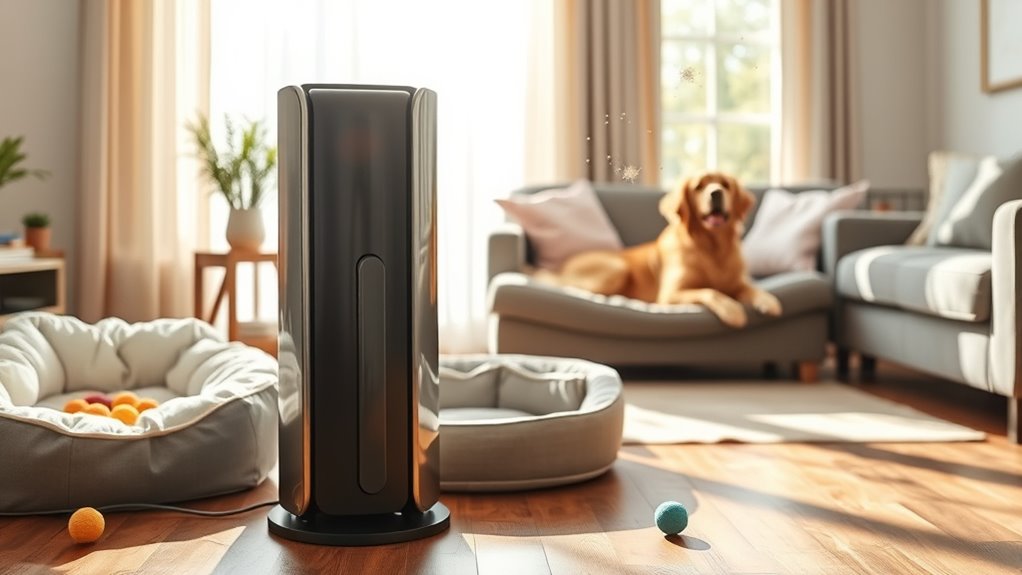
Managing pet dander doesn’t have to be a challenging task if you adopt a balanced approach. For pet owners seeking a cleaner home environment, regular grooming is essential.
Brushing your dog 3-4 times a week or your cat weekly can lead to a significant reduction in dander. Air purifiers help improve air quality by using HEPA filters that capture 99.97% of particles, including pet dander.
To further manage airborne dander, maintain a clean indoor environment with HEPA vacuums and hard surface flooring. Designating low-allergen zones in your home enhances your indoor air quality, keeping pets to specific areas.
Continuous operation of air purifiers, especially where pets spend the most time, contributes to a healthier indoor environment for everyone.
Best Air Purifiers for Pet Owners
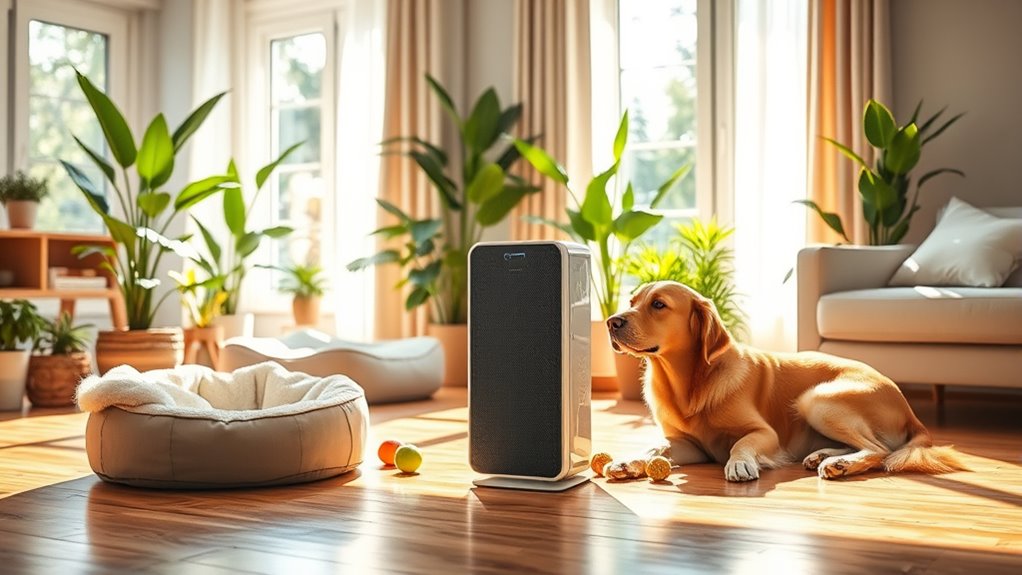
If you’re a pet owner looking to improve your indoor air quality, choosing the right air purifier is key.
Here are some features to take into account when selecting the best air purifiers for pet owners:
- True HEPA filters: They capture 99.97% of particles as small as 0.3 microns, effectively trapping pet dander and allergens.
- Activated carbon filters: Essential for neutralizing pet odors and adsorbing VOCs.
- Clean Air Delivery Rate (CADR): Aim for at least 200; it should ideally match two-thirds of your room’s square footage.
- Multi-stage filtration systems: These enhance efficiency and longevity by capturing larger particles like pet hair.
The Impact of Air Purifiers on Your Well-being
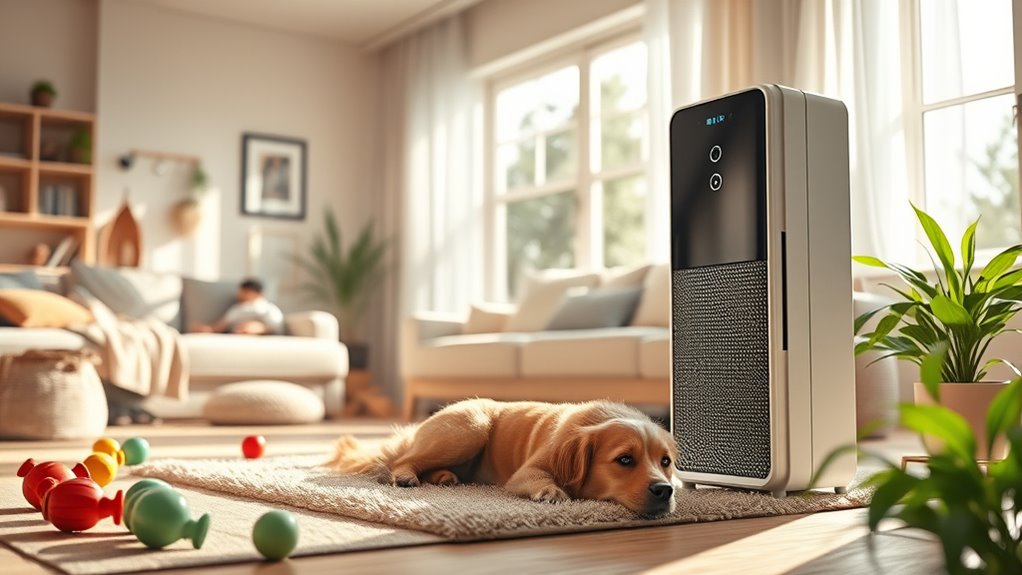
While you mightn’t realize it, the air quality in your home greatly affects your well-being, especially if you have pets.
Air purifiers equipped with True HEPA filters can capture 99.97% of particles, effectively trapping pet dander and helping to reduce allergy symptoms for both you and your furry friends.
By continuously operating these devices, you can markedly improve air quality, creating a healthier indoor environment. This not only promotes better respiratory health but also lowers exposure to allergens that can linger in homes with pets.
Additionally, air purifiers can eliminate pet odors, contributing to a more pleasant living space.
Ultimately, investing in an air purifier can enhance your quality of life and foster a happier home for everyone.
Frequently Asked Questions
Are Air Purifiers Good for Homes With Pets?
Yes, air purifiers are great for homes with pets. They effectively capture pet dander and other allergens, improving your indoor air quality.
With regular use, you may notice a reduction in allergy symptoms, making your living space more comfortable. Look for models with HEPA filters and a Clean Air Delivery Rate suitable for your room size.
Plus, many purifiers help eliminate pet odors, creating a fresher environment for you and your furry friends.
What Is the Best Air Purifier for Dog Hair and Dander?
Imagine a home free from pesky allergens, where you can breathe easy.
To tackle dog hair and dander, you’ll want an air purifier with a True HEPA filter, capturing 99.97% of particles. Look for one with a Clean Air Delivery Rate (CADR) of at least 200 and a multi-stage filtration system.
Don’t forget regular filter changes every 3-6 months to maintain peak performance. Your furry friend deserves a fresh, clean environment too!
Is There a Downside to Air Purifiers?
Yes, there are downsides to air purifiers. They mightn’t capture all allergens, especially if particles are too small for certain filters.
Regular maintenance is essential; clogged filters can lower efficiency and even recirculate pollutants.
Some models use ionization technology, which may produce ozone that can worsen respiratory issues.
Plus, the initial cost and ongoing expenses for filter replacements and electricity can add up, making them less appealing for some users.
How Do I Limit Pet Dander in My House?
You’d think having a furry friend means you’ll never escape shedding, right?
To limit pet dander, start by grooming your pets regularly—brush them 3-4 times a week.
Invest in a vacuum with HEPA filters and clean hard surfaces often.
Create low-allergen zones to keep your living space fresh.
Finally, don’t forget to change your air purifier’s HEPA filters every few months.
You’ll breathe easier, even if your pet doesn’t quite get the memo!
Conclusion
In the grand dance of life with your furry friends, managing pet dander doesn’t have to be a chore. By inviting an air purifier into your home, you create a refreshing atmosphere that nurtures both you and your pets. With a little TLC and the right strategies, you can enjoy all the joy of pet companionship while keeping your space healthy and inviting. Embrace the harmony and let your home be a sanctuary for all!
